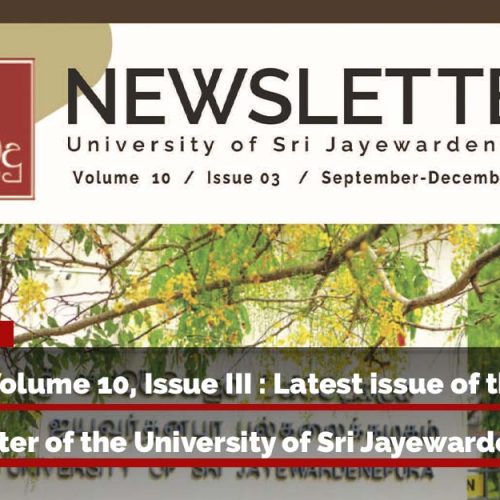The island of Sri Lanka appears to have been colonized by the Balangoda Man (named based on the area where his remains were discovered) prior to 48,000 BP. Pahiyangala cave in Bulathsinhala (48,000 YBP), Batadombalena in Kuruwita (28000 YBP) Belilena in Kithulgala (27000 YBP) are the most famous sites that yielded the evidences of Sri Lankan Prehistoric Man. These time periods falls in to the Late Pleistocene (Pleistocene 126,000 to 11000) epoch in the Quaternary period.

Fig. 01: Geological Time Scale
Nevertheless Prehistoric man of Sri Lanka has been identified as a group of Mesolithic hunter gatherers who lived in caves in the Mesolithic Period. The “Mesolithic” or “Middle Stone Age” was a period which assigned its name based on the development of tool technology between the Paleolithic and Neolithic periods of the Stone Age. According to S. U. Deraniyagala Sri Lankan Mesolithic period existed in the period between 40000 YBP to 5000 YBP. Pahiyangala cave in Bulathsinhala (48,000 YBP) Batadombalena in Kuruwita (28,000 YBP) Belilena in Kithulgala (27,000 YBP), Alu Lena in Aththanagoda (10,500 YBP), Bellan Bendi Pellassa in Ambilipitiya (6,500 YBP) has yielded for the most early evidences of the anatomically modern human in the South Asian region represented the Mesolithic period of the Sri Lankan prehistory.
Based on the physical anthropological and archaeological remains of the Late Pleistocene prehistoric man, subsistence patterns have been discovered. Archeologists have claimed that they had been in the stage of hunting and gathering and have assumed that they had been shifting their habitat in accordance to the cycle of the rain and the availability of the foods in the environment.
Rice Consumption
“Sri Lankans have used rice from the Late Pleistocene Epoch” according to the results obtained through a new research titled “Late Pleistocene Humans used Rice in Sri Lanka: Phytolith Investigation of the Deposits at Fahien Rock Shelter”. It has written based on the Phytolith (microscopic plant silicate bodies) evidences that they found through excavations conducted at the Pahiyangala cave. These evidences has shown that the anatomically modern humans lived at Pahiyangala cave in the south-western Sri Lanka intensively used wild rice species (e.g. Oryza cf. nivara) in association with lowland rain forests from 47.80ka (47.800 calyrs BP). Researchers have assumed that this intensive use of wild rice could be a local innovation.

Figure 2: Reconstructed Image of Balangoda man and Map Demonstrates the Prehistoric Sites in Sri Lanka
Animals Exploited for Food
Majority of the food consumption by the prehistoric man of Sri Lanka had been based on animal foods. Exploited animals for food were: elephant (young), gaur, water buffalo, sloth bear, pig, sambur, spotted dear, muntjae, chevrotain, porcupine, hare, giant squirrel, flying squirrel, pangolin, civet cat, monkey, jungle fowl, spur fowl, python, land-monitor lizard, hard and soft shelled terrapins, star terrapins, mahsier and various species of small fish, fresh water crabs and mollusks and terrestrial and arboreal mollusks, notably of the genus Acavus.
The incidence of heavily worn teeth in prehistoric man has suggested that certain food plants had high grit content or that they had been processed on gritty surfaces. The conspicuous absence of caries and dental abscesses in prehistoric man could be at least partially due to the use of masticatories which apparently had this beneficial effect among the veddas. The lack of silica gloss on artifacts suggests that cereal harvesting was not of much significance in both the Dry and Wet Zones. The general robusticity of the bones of prehistoric man for instance at ca. 18500 and 12000 BP at Batadombalena and BellanBendiPelessa respectively indicates a subsistence strategy in homeostasis with the environment so as to provide a balanced range of nutrition. There appears to be a tendency for the smaller vertebrates such as porcupines to be more frequently represented than the bigger forms such as bovines. This probably reflects the fact that the smaller animals were easier to hunt than the more formidable ones such as the gaur, and that the heavier carcasses were butchered at the kill sites, rather than any deliberate selection for the former by prehistoric man.
Exploitation of Plant Foods
As for the exploitation of plant foods, many of the prehistoric sites in the Wet Zone’s lowlands have yielded remains of the wild edible nut termed kekuna. At Kitulgala, wild breadfruit, which is rich in starch and fats, has been baked and eaten from the earliest occupations (at well over 12,500 BP) on wards. The wild banana, which grows in the vicinity of Kitulgala, has also been found among the food remains within the cave. The plant material from Batadomba and Kitulgala such as yams and the palms such as kitul and dotalu for starch, sugars from fruits such aspalu and veera, and numerous other forms to meet various dietary requirements.
Some of the places in the Mesolithic period have found grinding stones which may have used to grind rigid grains. Some of this grinding stones have holes which may have used to get the kern of the fruits. This people may have cultivated plants related to the Kurakkan family. Based on the Batadombalena excavations Deraniyagala suggested that they may have cooked their meal but based the small size of the fire place he has assumed the number of the group to be very small. As mentioned earlier they may have lived as small group in order to facilitate the food gathering system as gathering wasn’t easy at that time.
Animal Domestication
The skeletal remains of dogs from Nilgala cave and from BellanBandiPalassa, dating from the Mesolithic era, about 4500 BC, suggest that prehistoric man (Balandoga Man) may have kept domestic dogs for driving game. The Sinhala Hound is similar in appearance to the Kadar Dog, the New Guinea Dog and the Dingo. It has been suggested that these could all derive from a common domestic stock. It is also possible that they may have domesticated jungle fowl, pig, and water buffalo.
Balangoda Man also appears to have been responsible for creating Horton Plains, in the central hills, by burning the trees in order to catch game. However, evidence from the plains suggests the incipient management of Oats and Barley by about 15,000 BC.
Sea Food Consumption
Excavations in Batadomba Lena Cave in Kuruwita and UdupiyanGalge Cave in Rathnapura have exposed fish remains indicating that the man had been consuming fish for the last 40,000 years or more. The first evidence of fish remains was discovered in Batadomba Lena Cave. The species was identified as Mahseer; Tor longispinis (synonymous T. khudree) and that evidence have helped conclude that the Mesolithic man was a fisherman in certain parts of Sri Lanka (Deraniyagala 1939). And therefore it might be safe to mention that the prehistoric man was a fisherman cum hunter-gatherer.
Wild-caught fish is still an important dietary component in Sri Lanka. Fishing was an important activity among the aboriginal people of Sri Lanka known as Vedda since early 20th century according to the literature. Fishing in village ponds was very common among Vedda and drought stricken ponds were thrashed with slender sticks until the fish were actually struck and became immovable in order to capture them. Fishing with ichthyo-toxic plants was also an important activity among them during the early 20th century. It has been reported that Veddah have consumed freshwater eels, snakeheads, catfish and about 19 other smaller varieties but they have never used traps for fishing.
Prehistoric man of Sri Lanka were hunter-fishermen-gatherers who had their dwellings near bodies of fresh water, the expansion of dietary variety to include coastal sources of food was a new development. The earliest evidence from a coastal site for marine mollusk consumption in Sri Lanka was found at Pathirajawela, dated to between 74000, 64000 and 28000 BP. The earliest evidence from an inland site was from the Kuruwita Batadombalena cave. Thus subsistence of Sri Lankan prehistoric man has been consisted varieties of Small size animals to the large animals may be as a result of scavenging. Majority of their diet has covered frommolluscsand other small size vertebrates. Further they have been practicedfishing as well as majority of the women has supported by gathering of yams, plant and grains.
Written by :
Tharaka Ananda
(BA. Spe. Anthropology),
University of Sri Jayewardenepura
References
- Algiriya P.A., Weliange W.S., Adikari G., Chandrakumara S &Manamendra-Arachchi K. 2009. Fish remains from AlawalaPothgul Lena Cave. Hunting for hunter-gatherers at AlavalaCave.Symposium on new discoveries from the excavation at Alavala. 3rd November 2009. Post graduate institute of Archaeology, University of Kelaniya, Colombo 7. Sri Lanka. 86p.
- Deraniyagala, S. U., (1977) PragEythihasikaJanawasa, Ape SanskruthikaUrumaya, Gunasekara, Bandusena (Ed), MD Gunasena, Colombo
- Deraniyagala, S. U.,1992, The Pre History of Sri Lanka; an Ecological Perspective Colombo : Department of Archaeology, Colombo
- Deraniyagala, S. U. (1997) PragEythihasikaPasuthalaya, MahaweliWanshaya, MahaveliKendraya, Colombo.
- Deraniyagala, S. U., 1985, The prehistory of Sri Lanka, An Outline, Festschrift, by A. R. B. Amarasinghe, S. J. Sumanasekara Banda (ed), Sri lankaUnesco national Commission
- Deraniyagala, S. U., 1997, Sri LankawePragsahaMulaEythihasikaJanawasa, Arthikawimasuma, November, PP 4.
- Manamendra-Arachchi, K., Pethiyagoda, R., Dissanayake, R. , Meegaskumbura, M., 2005, A second extinct big cat from the Late Quaternary of Sri Lanka, , The Raffles Bulletin of Zoology, Supplement, Vol 12, 423-434pp.
- Manamendra-Archchi K.N., Perera J., Weliange W.S., Thantilage A., Karunarthne W., Adikari G. & De Silva N. 2009. Checklist of fauna found in the excavation of prehistoric AlavalaPotgul Lena Cave. Hunting for hunter-gatherers at AlavalaCave.Symposium on new discoveries from the excavation at Alavala. 3rd November 2009. Post graduate institute of Archaeology, University of Kelaniya, Colombo 7. Sri Lanka, 86.
- E. P. Deraniyagala commemoration volume, 1980, Gunawardana, Thelma T. P (Ed.), Colombo : Lake House Investments.
- Premathilake, R.; Chris, O. H.; Perera, N.; Wedage. O. (2017). Late Pleistocene Humans used Rice in Sri Lanka: Phytolith Investigation of the Deposits at Fahien Rock Shelter, Global Journal of HUMAN-SOCIAL SCIENCE: D History, Archaeology & Anthropology, Volume 17 Issue 2.
- Weliange W.S. (2015). Fishing in Prehistoric Sri Lanka. In: Perera P (eds) Festschrift in Honour of Professor S.B. Hettiarchchi.










